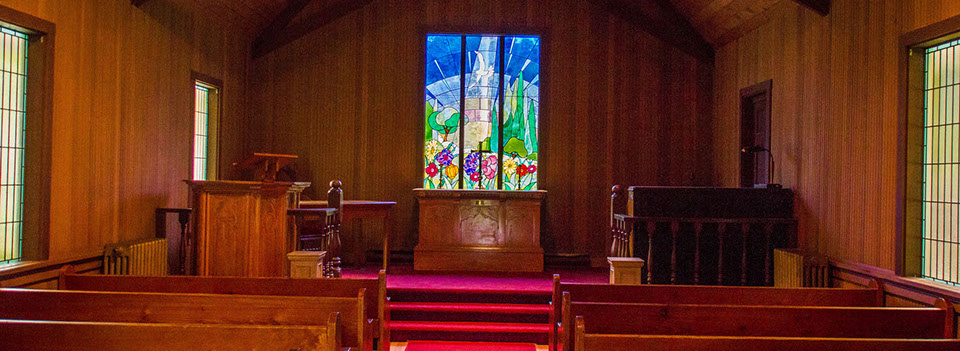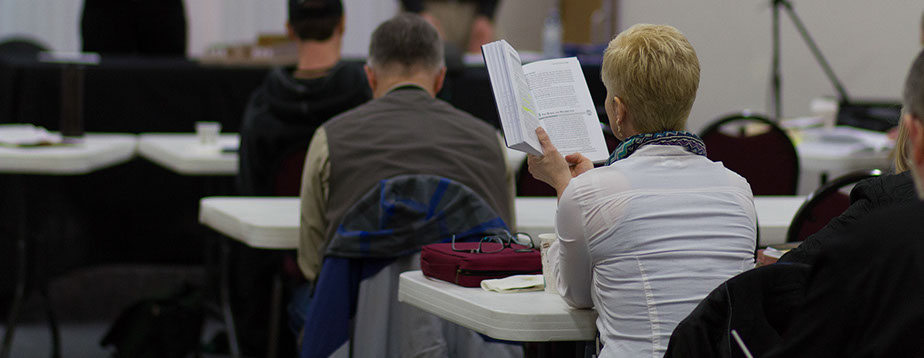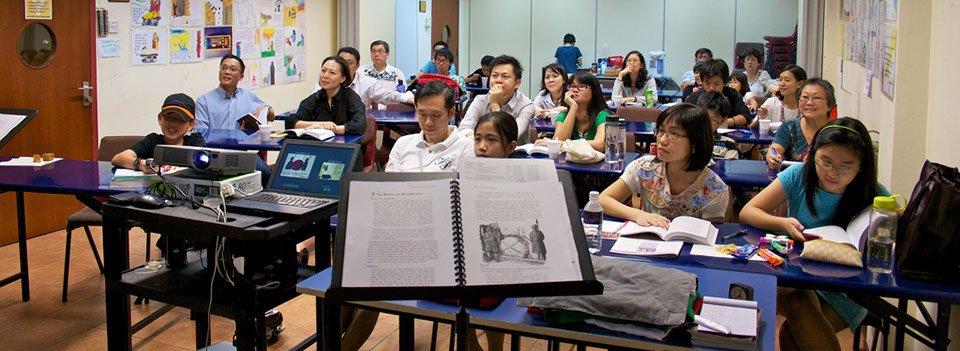HOW GOODSEED TOOLS CAN HELP YOU
TRAIN YOUR CHURCH IN THE GOSPEL
(Reading time: 25 minutes)
In this “How to Train” series, we describe practical ways in which believers worldwide use our tools to share the message of the gospel.
In this article, we look at how you can use GoodSeed resources to help your church gain a clear understanding of the gospel and then train your congregation to share the gospel. We make no claims to having all the answers to the many challenges churches face. However, we want to share some strategies we have seen work well in different church environments.
So, whether you are a pastor, elder or church leader, we hope you will find these tried-and-tested suggestions helpful. We also invite you to share your own experiences with us to benefit others. You can write to us via our contact form.

Every Sunday, as pastors stand up to preach, they have seated before them among their congregation…
- those whom everyone assumes are Christians because of their unfailing presence in church but who, inexplicably, have remained unbelievers.
- others who may be relatively young believers or who, though they put their trust in Christ years before, are still in spiritual infancy. Collectively, these find it difficult to explain the gospel to others because their own understanding is not clear.
- still others who are “spiritually mature” believers but who have lost their sense of passion and vision for a needy world.
Adding to the challenge of ministering to our current generation is the reality that…
- we live in a kindlele society. Many are new to our communities and we know little about the background of those who become part of our churches.
- "church hopping" is a common phenomenon.
As a pastor, you always welcome the opportunity to minister to new faces in your congregation...
...but how can you effectively do so in a way that is relevant to their most fundamental need—that of having a right relationship with Christ—if you are wanting to focus on building up the believers?
Presenting a similar difficulty is one faced by pastors in more isolated settings. Because of the limited choice of churches, pastors typically find that their congregations are made up of those who represent a wide variety of denominational backgrounds—from evangelical to theologically liberal. The consequence may be a broad spectrum of understanding of key biblical truths. Again, the challenge is addressing all the divergent needs of his congregation, particularly the need for salvation.
Furthermore, we mustn’t forget the children and young people:
- Every generation must be reached with the gospel. Not only is the church faced with the challenge of reaching its present generation, but it must also take steps to ensure that it does its part in laying the groundwork for reaching yet future generations.
- Though it is the primary responsibility of Christian parents to evangelize and disciple their children, the church must be there to supplement and support.
- At the same time, churches must be prepared to reach children coming from unsaved homes and from homes where the children are not being trained and nurtured.
Thus, as the pastor, you are faced with the ongoing challenge of how to best minister to a diverse range of needs within your congregation—even before a church begins to consider outreach strategies that address the spiritual needs of the community surrounding you.
GoodSeed has developed a variety of resources that churches can use in both evangelism and discipleship.
These resources are useful for:
- grounding each of your congregants so they have a solid understanding of the gospel. (Remember: a clear presentation of the gospel flows out of an accurate understanding of the gospel.)
- ensuring each congregant is confident on how to share the gospel message.
- preparing your church to be ready at all times to share the gospel with visitors and newcomers.
- getting your church to actively reach into its community with the gospel message.
There are resources for different age groups. We have been encouraged by how different churches have used these tools to work towards training a congregation to be effective ambassadors for Christ. (See the section on Resources for more details.)
While your church needs to adapt this approach to meet your situation, the following table outlines the general steps to train the church. We will go through each stage in detail.
the challenge is addressing all the divergent needs... particularly the need for salvation
The Challenge faced by pastors and church leaders

Summary of the approach
Stage I: Solidify
Create strong foundations in understanding the gospel.
This stage focuses on grounding the congregation in the same solid understanding of the gospel. The steps are:
- Learn the approach of the Worldview Rethink course and refresh yourself in the gospel.
- Lead the initial course for the leaders or elders of your church.
- Multiply by systematically training the entire congregation.
Stage III: Reach Out
Reaching out to your community.
This stage focuses on outreach programs that share the gospel in the community.

Stage I: Solidify Create strong foundations in understanding the gospel
This initial stage involves getting your congregation on the same page with regards to the gospel. Here is the chance to share the gospel in a comprehensive manner with those sitting in the pews who may not be believers. At the same time, this is the opportunity to rekindle in the hearts of mature believers excitement in the significance and power of the gospel message. (2 Peter 1:12-13)
1. Learn the approach of the course and refresh yourself in the gospel.
Familiarize yourself with the training course curriculum that you will use in your church. There are three options:
- Worldview Rethink with By This Name
- Worldview Rethink with The Stranger on the Road to Emmaus
- Worldview Rethink with All that the Prophets have Spoken
Learn the difference between the three curricula >>
Begin by reading the course book (The Stranger on the Road to Emmaus, All that the Prophets have Spoken, or By This Name) to see how the gospel message is presented as a historical narrative, from creation to the cross. Then look through the corresponding leader’s guide to see how the course is run.
Learn why architecture of our tools is unique >>
Then familiarize yourself with the visual aids, video clips and workbook. These tools are designed to work together to provide a clear explanation of the gospel.
Finally, select a co-leader and have him or her go through the curriculum as you did and prepare to lead the first course together. (See below for advice on running a course.)
Another option for familiarizing yourself with this course would be to use GoodSeed TERM for Small Groups.
See more on TERM for Small Groups >>
2. Lead the initial course for the leaders or elders of your church.
Once you and your co-leader are familiar with the curriculum, organize the first course. Ideally, you should start with your church leadership. It’s crucial that the key leaders of the church understand the goal and the content of the curriculum.
3. Multiply the effort by systematically training the entire congregation.
Once the church leadership understands the curriculum and the strategy, it’s time to multiply the effort among the congregation. What you want to do is get as many congregants to go through the course in as short a time as possible so as not to lose momentum. This is still a foundational discipleship step to train the church for evangelism.
Case study:
One pastor told us how he did it with his congregation. He led the first course with the church elders while his wife lead a second study with their wives. They met once a week for several hours, finishing the class in eight weeks. Subsequently, these leaders led small groups, teaching in pairs until everyone in church had completed the course.
Here are some suggestions to get the whole congregation involved:
Small groups
Use the existing small groups in the church. Get the group leaders to first learn the curriculum by attending a course led by you or other church leadership. After that, the small group leaders can lead their own groups.
Set aside a period of time (e.g. three months) to allow all the small groups to go through Worldview Rethink as their study material. Encourage the groups to complete the class as quickly as possible. Don’t drag it out over months.
Seminars
Some have arranged for the course to be completed over a period of three consecutive Saturdays, five hours each time. Others have used two three-hour blocks on Thursday and Friday nights, then a full day on Saturday.
Retreats or church camps
A three-day Saturation Weekend or retreat for the church. Start on a Friday evening and finish on a Sunday. A camp or a similar venue will make this a great getaway event, providing an unique opportunity for your members to get into the Word and fellowship with one another.
Adult Sunday school class
If your church already provides opportunities for adults to study the Bible on Sundays, then consider using the Worldview Rethink curriculum for one or more of these classes.
This is not a mechanical exercise to get all of your church to simply go through the same class material.
The Worldview Rethink course is designed to avoid religious jargon and focus on the core message of the Bible: the life-giving gospel of Jesus Christ. We have seen Worldview Rethink give both unbelievers and mature believers the confidence in the Word of God and boldness in faith.
As you follow these suggestions, reach out to as many of the congregation as possible. Encourage those not in small groups to join one now, or organize special classes or groups just for the purpose of going through a course.
Case Study: Once after leading such a course in a church, one of our staff members was stopped by one of the participants. Expressing thanks, she said “My husband and I never understood the connection of Jesus with the lamb. We always thought that being a believer was following in the footsteps of Jesus and doing the best you can.” This happened in a good church where the gospel was taught. For years, this couple had helped in Sunday school and the wife had been superintendent. In spite of all this, she had not understood the gospel.
At the end of this exercise, two things should emerge:
> First, the congregation is clear about the gospel message and enthusiastic about it.
> Second, the congregants will have learned how to lead a course.
When your church completes this foundational step, the congregation is now ready for Stage II.
The Worldview Rethink course is designed to avoid religious jargon and focus on the core message of the Bible.
Some advice on conducting Worldview Rethink courses
No more than eight weeks. Ideally, the class should be completed in no more than eight weeks. The impact of the gospel message is powerful when the continuity of the narrative is preserved. As in reading a book, if it takes too long to complete, participants forget details, interest wanes and the impact of the gospel narrative is diluted.
Two-hour sessions. A minimum of two hours should be planned for each teaching session. This doesn’t include any fellowship, administrative matters, prayer or worship. Because we want to keep the course tight and moving forward, it is important to have a good portion of teaching for each session.
Regular attendance. It’s important that course participants don’t miss or skip sessions. Because the gospel is told as a historical narrative, when a person misses sessions, it’s hard to maintain a clear perspective on the content. It’s like skipping portions of a movie or chapters in a novel. There will be gaps in one’s understanding, creating a weak foundation at best and misunderstanding at worst.
It would be ideal if all participants can commit to full attendance. However, in the event that a session is missed, he can catch up by reading the relevant sections of the book before the next class. This same goal of full participation would apply for any participant of the course sessions mentioned below, including church visitors.
Course size. While the number of course attendees is flexible, the ideal group size is no more than eight. The intimate size fosters greater interaction and models the idea of doing the study in a small group or home Bible study setting. Naturally, if small groups are already in place in your church, there is no need to adjust the group size
In preparation for a Saturation Weekend or camp, it will be important to maintain the focus of those times with a larger group on the gospel. Every participant will need to be provided with the course book, workbook and highlighter so they can follow along.
Use dynamic reading. This course is designed to be easy to lead and the method of teaching is very transferable. We like to say that “if you can read, you can lead.” While we recognize that your church may have very gifted communicators, we recommend following the format of dynamic reading as explained in the leader’s guide. This is because the key intent of this curriculum is transferability.
If you teach in a way that is unique to you or in a way that only gifted teachers can follow, it will not be transferable. Your first group might be very impressed with your communication skills, but they might also feel unable to mimic your style. The reality is that no one has the necessary time to teach every member of his congregation in-depth. You will find that modelling a method that allows anyone in your congregation to become a teacher will be very beneficial.
This is what one leader said, “In our church, we were trying to raise up a group of facilitators who were trained to lead others through the gospel using Worldview Rethink. When my co-teacher and I taught it lecture style, no one dared to volunteer to teach others. While they were impressed with how well we taught, they were also intimidated because they felt they could never be like us. When we changed to the dynamic reading method, we were able to raise up a group of leaders who said they could teach just as we did. The dynamic reading method of teaching allows for transferability. Our courses have been running for three years now.”
Another seasoned missionary said, “I know how to teach. But I figured the curriculum developers designed the material to be used by even an inexperienced leader. So I followed each instruction, knowing that as I was teaching, my students were also learning how they would lead their future groups.”
The purpose of teaching with the dynamic reading method is to empower all church members to teach. The motto of “as you are taught, so you will teach” applies here. Not every one is a gifted communicator, yet all believers are called to share their faith. This is why the Worldview Rethink curriculum was designed so that even non-gifted communicators will be able to lead a course with confidence.

Stage II: Reach In to church visitors
This is the point where you organize a team that is ready to invite newcomers to your church to a Worldview Rethink course. Every church gets visitors. New people move into the neighbourhood; church members bring friends. A Christmas play draws in those who are curious. Still others simply show up at your door because they want to find out "what church is all about.”
It’s always wonderful when new people come to church. Some may be unbelievers. We need to take the opportunity to offer them a clear presentation of the gospel message. Too often we have heard unbelievers say they have visited churches but still understand little about what Christ has done for them.
Though many of these new faces will already be believers, it is also very appropriate to invite them to a Worldview Rethink class. Not only will they find it spiritually invigorating, but it will also give them an opportunity to learn what are the core convictions and priority of this church they are visiting.
Regardless of who the visitor is, it is always ideal for churches to be on the lookout for opportunities to share the gospel with newcomers to their midst.
(For a full description of the various roles involved in Stage II, see the Appendix below.)
Quick overview of how to take visitors through a course
Visitors are greeted and invited to attend a course about the Bible. There’s no obligation to participate but your church greeter will let the visitor know that the class will give a good overview of what the Bible’s message is and what it says about life, death and life after death.
At the class, course leaders will take the visitors through the Worldview Rethink curriculum in exactly the same way that your congregation was taught. Following the dynamic reading model, study leaders use the leader’s guide and the visitors will have the course book and workbook. Leaders will also employ the visual aids and videos as part of the course. Go as fast as you can, but as slow as you must for clarity and good understanding. Course leaders should not push for belief, but comprehension. Let the Holy Spirit do the work of convicting.
Details
The course coordinator is the overall person in charge of ensuring the program is running and there are leaders scheduled to run courses.
Frequency
In order to best accommodate visitors, decide how often a new Worldview Rethink course will start. Once a month? Once every two weeks? On the same Sunday that a visitor agrees? This will depend on how many trained leaders you have. Visitors are invited to join in the next available class. You’ll want them to start as soon as possible once they have expressed interest.
Some churches may be able provide the start of a new class the same Sunday that the visitor expresses an interest . For instance, if the course leaders are a couple and a visiting couple signs up, the four of them have the flexibility to start right away. Thereafter, the course leader can arrange the subsequent sessions around the visitors’ schedule.
The study can run before, during or after service time each week. It can also be run on weekdays or nights, depending on the leader’s and visitors' schedules. Venues can be at the church, a study room at the community public library, the leader’s home, or whichever location is more convenient and appropriate.
Flexibility
These courses should be flexible, running at the convenience of the visitors. However, whatever the arrangement, leaders need to make every effort to work through the course material as quickly as possible. We do not want the gospel to lose its urgency, nor to we want our seeker to lose sight of the big picture of the gospel due to a study that drags on for many weeks. Some visitors can meet twice a week, others just once a week, so arrange accordingly.
You do not need to wait until you have a quorum to start the course. You may have only one family express interest. You should feel free to start as long as the family is comfortable with it.
Befriending
As the course progresses, leaders should introduce the visitors to other members of the congregation. The goal here is to help build bridges between the visitors and the congregants of your church.
While every person in the church should play a part in making the visitor feel welcome, it helps to have a special group of befrienders who are intentionally developing friendships with newcomers.
See the Appendix for more details on how befrienders function >>
Follow up
At the end of the course, the leaders should discuss with the visitor if he or she has understood the message. Do not force belief, as that is intimidating but instead strive for understanding. It is the Holy Spirit’s job to convict a person, but our jobs to explain the gospel clearly. If the visitor has questions, offer to do follow-up sessions to address them. If the visitor demonstrates understanding (the curriculum explains how to check for this), encourage him or her to continue their learning journey within a small group and the weekly services. Ensure that a leader or befriender keeps in touch with the visitor.
If the visitor is unable to join a course
If a visitor seems hesitant to commit to a course or doesn’t have the time for it, then make sure your greeters have on hand copies of books like The Story that Matters or By This Name to give to the visitor. It is vital that they leave with an opportunity to gain a clear understanding of the gospel. Let your visitor know that should he or she want to join a class at a later date, a course leader will be happy to help.
Offer visitors the opportunity to get a clear presentation of the gospel message.
Start as soon as you can... on that very Sunday if possible.
1. Guiding a course
2. Giving away the gospel
A Be Ready Box (Giving away a gospel tool)
There will be occasions when a visitor is unable to attend a Worldview Rethink course. In those cases, giving him or her a book that explains the gospel is a good idea.
GoodSeed resources are not just designed for teaching but they can be given away like a gospel tract. But unlike a brief explanation, these tools take the necessary time to provide the background information essential to understanding who Jesus is and what he accomplished on the cross. These resources were designed with the biblically illiterate in mind. By biblically illiterate, we mean people who know very little or nothing about the Bible.
Based on what would be most appropriate for your community, you can select tools that will be helpful for your church. Ask a team to select and pack resources into a Be Ready Box that is stationed at the welcome center, ready to be used when a visitor arrives.
For example, if your neighbourhood has many people from China, Taiwan or Korea, then you can select our resources in those languages for the Be Ready Box.
So in this example, your Be Ready Box would include:
- By This Name
- The Story that Matters
- By This Name in Simplified Chinese and Traditional Chinese
- The Stranger on the Road to Emmaus in Korean
- The Lamb in Mandarin
- The Lamb in English
Then, should a visitor be unable or unwilling to attend a course, you can still leave him or her with a clear gospel presentation.

Stage III: Reach Out to the community
Ultimately, the purpose of the church is to be reaching its community, to be the light and salt right where it is located. The Bible gives us the mandate to “go into all the world and proclaim the gospel to the whole creation” (Mark 16:15 ESV). So rather than just bringing people to church, the church needs to step into the community to share the gospel.
1. Worldview Rethink courses (home-based)
Encourage your congregation to invite friends, family, loved ones, neighbours and co-workers to a course in their homes. Often, unbelievers will be unwilling to step into church, but may be willing to learn about the Bible in the comfort of a friend’s home.
2. Worldview Rethink courses (church-based)
Stepping into the community, your church can offer courses at public libraries, community centres, senior housing communities, nursing homes, learning centres and of course, your own church. There are publicity resources in the curriculum package that you can use to publicize these courses.
See the publicity resources >>
Make these classes available several times a year. Assign or ask for volunteers to lead them. Encourage your congregation to invite their friends to attend. This is one of the most effective ways of reaching out to the community.
Learn how a church in Derby, UK regularly runs such groups >>
Read the impact that a course had on one man >>
Your church may have other programs for the community (child care, single mothers’ support groups, English classes, and more). Take the opportunity to invite those involved in other programs to a Worldview Rethink course.
3. Offer courses for other ministries
In your town, there may be other Christian organizations that are reaching into the community. Pregnancy care centres, boys' and girls' clubs, YMCA, shelters for the homeless, seniors' homes, nursing homes, Christian schools and more all have people who may like to learn more about the Bible. Consider partnering with them. Offer to run Worldview Rethink courses regularly with them at their locations or at your church. In this way, the body of Christ works together for the sake of the gospel.
Read an example of running Worldview Rethink at an academy for seniors >>
4. Camps and retreats
If your church runs vacation Bible schools, camps or retreats for the community, consider incorporating Worldview Rethink into the schedule. Break up the 16-hour curriculum to fit into the schedule of the camp. You might choose to divide the campers or participants into small, manageable groups.
5. Parents’ courses
If you are running a day camp, summer camp or something similar for children, why not organize a course for the parents, too. It’s a great opportunity to invite unchurched parents in for their own study of the Bible’s message while they wait for their kids to finish their time at the club.
6. Special classes in the church
Even though we began this evangelism strategy by asking you to ground your own congregation in the gospel, over time there may be new members and others in your church who would not have attended a Worldview Rethink course. These people should be invited to join in one of the scheduled classes. In addition, however, there are other opportunities to be part of a course. Here are some ideas:
Pre-baptism class
It would be ideal for those preparing for baptism to refresh their understanding of the gospel.
Membership class
Prior to accepting new members or accepting members transferring from other churches, going through the gospel would allow them to “get on the same page” regarding their understanding of the basis for their salvation.
New parents' class
Before a couple welcomes their first baby, help them prepare by learning how to clearly articulate the gospel as a necessary ingredient for raising their family. Have them go through Worldview Rethink and at the end of the course, spend time on how parents can explain the good news to their children.
Learn more on how to guide a family through the gospel >>
Young believers' class
If young believers are able to get a good grasp of how to articulate and explain the gospel, they will be equipped to start sharing their faith from a very early stage. Many recent believers still have a good network among their unbelieving friends and when they are asked about why they are believers or what the Bible is all about, they will be prepared to share.
Evangelism class
Members of the church who would like to be trained in sharing the gospel can take this class. This class would be good for those who are being appointed as mission team leaders, camp leaders, summer ministries' director and so on.
Sunday school teacher training
Before a person is commissioned as a Sunday school teacher, have him go through Worldview Rethink. In this way, the new teacher can answer questions and explain the gospel consistent with the church statement of faith. This avoids possibly confusing students and encourages everyone in the church to use the same explanations and verbiage.
Work with other ministries to offer courses in the community
Train young believers on how to share the gospel

Isn't this a lot of time and effort?
Yes it is. But as the body of Christ, we have been given the mission of being ambassadors. We are to take the gospel that Christ entrusted to us and share it with those who have not heard it before. The church’s mission is to reach those within its walls and those within the community and beyond with the gospel.
Taking the time and effort to ensure everyone who is a part of your church is grounded in the good news of Jesus Christ is a wonderful thing to do. You want to get the foundations right. Once a church member or churchgoer has the gospel clear in his head, many things happen.
- The congregation shares a common base of biblical understanding. Pastors can build upon this foundation.
- There is power in the believer’s life. An understood gospel is a powerful gospel.
- The believer is confident on how to share the message.
- Each member is an equipped and ready ambassador and the church will focus more on outreach.
- Your church can actively reach out to visitors and the community with the gospel.
We have seen churches that have taken the effort to ground their congregations in the gospel experience growth—spiritual growth in the lives of their members, and growth in numbers as these churches faithfully reach out into their community.

Resources
For guiding courses
Worldview Rethink
This is at the heart for the evangelism strategy. The curriculum includes:
- Leader’s guide
- Training videos
- Course books
- Workbooks
- Visual aids
- Video clips
You have a choice of By This Name, The Stranger on the Road to Emmaus and All that the Prophets Have Spoken.
Learn more about Worldview Rethink >>
The Lamb
This book was designed for children five years and up.
Using the same creation-to--Christ approach, it uses full-colour illustrations and a controlled vocabulary to explain the gospel message. Each chapter comes with review questions that help the teacher check if the children understand what is being taught.
For further training
For leaders who want to go deeper into how to share the gospel effectively, we have:
The Ambassador Series
This series investigates issues of evangelism as they relate to the message and method taught and used by Jesus on the road to Emmaus. It is appropriate for Bible believers, small groups, home studies, pastors, leaders in evangelism and missions, Christian schools and Bible students.
In-ká-hai: How Sweet It Is!
This is a case study on evangelism. It follows the true-life story of Pete and Leah Humphreys, who spent 17 years working with the Manjúi tribe in Paraguay. Despite being careful to present the gospel clearly, they ran into some big challenges.
The book chronicles what they did to overcome the challenges, and more importantly, see how it is applicable to ordinary believers anywhere in the world today. Includes a six-session study guide.
Appendix: The Team Roles
No matter the role, each team member needs to have gone through the Worldview Rethink course. This will get everyone comfortable because all will have a firm foundation and the same understanding. With everyone on the same page, you will broaden the pool of people from which to draw for the different roles described below.
It’s also important for your congregants to catch the vision of being ambassadors for Christ in church and in the community. No one should feel pressured to take on a role. Doing so will only result in it being done out of obligation or duty. You want people who are excited about the gospel and eager to share it!
These are the roles:
- Course coordinator
- Greeters
- Course leaders (or facilitators)
- Befrienders
- Youth and children facilitators (optional)
- Child care providers (optional)
These roles are suggestions. You can adapt to fit your situation. Small churches may not have enough personnel to fill all these roles. The key ones are the first four.
1. Course Coordinator
This person is in charge of the program. He or she is responsible for scheduling the courses and leaders. Depending on how many leaders you have, you can have courses ready to run each week, every two weeks or every month.
The course coordinator will need to work with those in charge of the welcome centre. The welcome desk team can take down names and contact numbers and pass them on to the course coordinator who will then make arrangements with the visitors.
2. Greeters
Greeters are the ones who identify and invite visitors to join a course. (This group might be your existing usher team.) You can also put in your visitor card an option to check: “Yes, I’m interested in attending a class to learn more about the Bible.” Or the greeter can chat with the visitor to offer the course. Either way, greeters direct interested visitors to the course coordinator (or welcome desk) to get the visitor signed up for the next class.
Caution: Greeters must be of good reputation. You don’t want newcomers to your church to be met by a disreputable businessman or woman. Greeters should be friendly in disposition. You want those who find it natural to build a quick rapport with strangers. And finally, greeters need to have a good memory for faces and names.
3. Course Leader (Facilitator)
Course leaders are the ones who guide visitors through the Worldview Rethink course. We recommend two leaders per course, team-teaching together.
You will want to recruit as many leaders as you can because there may be multiple courses running. For example, if you start a new course once a month, then in any given month, you may find your church has several courses running, each with visitors in them. And each course will be at a different stage in the curriculum.
Since Worldview Rethink is designed so that even leaders with little teaching experience can lead, do encourage as many church members to be scheduled as leaders. You can pair a more experienced one with a less experienced one. Some couples have also found this to be a very good ministry where they can serve together, reaching out as a team to other couples.
What’s important is that leaders have gone through the course as students and take the time to review the leader’s guide before they lead. You don’t need gifted communicators; you just need those who are willing.
There should be a regular meeting organized by the course coordinator for course leaders to share notes, discuss issues and pray together for their courses. Depending on the needs of the leaders, this meeting can be monthly, once every two months, or quarterly.
4. Befriender
One of the things we hear from newcomers is that it’s very hard to integrate into the church. Picture this: a visitor courageously steps into a building full of strangers. The people inside may smile and greet him, but everyone seems to know everyone else and he feels left out. And this goes on for many weeks as each church member assumes another will take care of the new visitor. Before long, the visitor leaves, as he feels unwelcome.
It is the responsibility of everyone in church to connect and befriend visitors and newcomers. But to help visitors out, you can consider forming a group of befrienders. This team is made up of people who are naturally friendly and enjoy taking care of people. This group intentionally befriends newcomers.
It’s a good idea to put together a befrienders' team comprised of people with different skills. So if a new family moves into town, the befrienders can offer help in setting up the new home. Electricians, plumbers, even a painting crew can be the team. At other times, befrienders can provide meals, babysitting or other forms of help. These are practical ways of showing Christ’s love and it goes a long way to helping newcomers feel a part of the church family.
One church regularly hosted international dinners for new students in their community. These dinners helped newcomers get to know church members in a relaxed and friendly atmosphere. Friendships were built and eventually, many newcomers joined in a course to learn the gospel message.
So while newcomers are trying out the church and attending a Worldview Rethink course, it’s important to also get other church members, these befrienders, to make them feel welcome and help visitors get to know more people in your church. All this needs to happen naturally and not feel forced or artificial.
Read about a lady who got to know a church through these international dinners >>
5. Youth/Children Facilitator
Often, youth, teens and children accompany their parents when they visit a church for the first time. Depending on the maturity of the child, but generally if they are 13 or older, they are able to attend the Worldview Rethink course with their parents. We have heard of children as young as nine fully engaged as they sat through a course.
The younger children, however, should be led in a special class that runs at the same time as the parents’ course. The book to use for children is The Lamb. A course leader can gather visiting children and read aloud from the book, one chapter at a time, and ask the children the questions. It takes an average of two hours to go through The Lamb. At the end of it, the children should have a good grasp of what the gospel is. After that, they can join Sunday school or children’s church.
Note: You will need to be sensitive to the parents’ wishes regarding their children. You may need to wait until the parents feel comfortable before putting their young children in class. Ensure you have their express permission to do so.
If there are a number of youth, you can run a Worldview Rethink course just for them. Being in their own course might encourage the young people to be more open and free to ask questions.
It’s really important that children and youth learn the gospel message for themselves as well. We have heard from churchgoers how their children and teens attend church simply because their parents take them, but once they are old enough, they stop attending. One key reason for this is that they’ve never understood the gospel message. Over the years, they were simply taught an unrelated collection of Bible stories and moral lessons. But they actually did not learn the gospel. Going through a Worldview Rethink course will help in learning the good news of Jesus Christ clearly.
6. Child Care Providers
If your Worldview Rethink courses are not running on Sundays when there are programs for children, it’s a good idea to have a team of people able to provide child care. If the children are old enough (about 4 years old and up), you can organize lessons centred on reading to them from The Lamb.
I WANT TO LEARN
ABOUT GOODSEED
The Monthly
GoodSeed eNewsletter
Sign up to receive articles, testimonies, sneak peeks of new resources & upcoming seminars. You'll receive a PDF copy of The Tabernacle: Model of Messiah as a thank you for partnering with us.
© 2023 GoodSeed International. All rights reserved.


